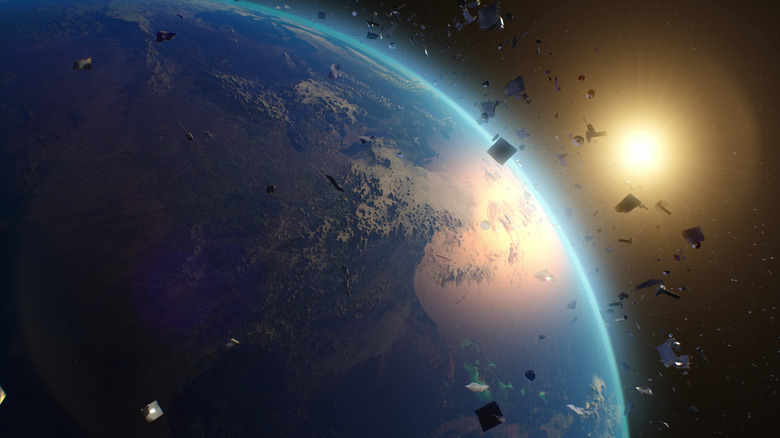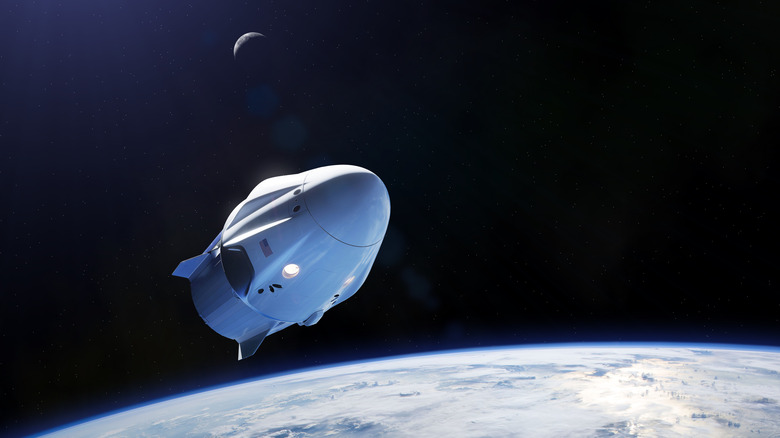How Much Space Debris Actually Falls Back To Earth?
Humans sure have a way junking things up. You ever walked down any street in any major city, besides exceptionally clean places like Tokyo? The sidewalk is basically a warzone of refuse and unnamable stains. Or how about the Great Pacific Garbage Patch, composed of 1.8 trillion pieces (at present) of life-choking plastic, per The Ocean Cleanup? What about that beloved Pixar movie, "WALL-E"? It was built on the concept of Earth becoming a junk planet maintained by robots who compress trash into orderly cubes. In that film, the humans lived off-world.
One thing that those "WALL-E" human migrants didn't have to worry about, though? Space debris. They and their spaceship didn't get punctured by a whirling maelstrom of planet-circling trash moving 10 times faster than a bullet, as Aerospace cites. In fact, as NASA states, even a "tiny paint fleck" spinning at such speeds could damage a spacecraft. And at present, there are more than half a million pieces of marble-sized junk ringing Earth like our own personal asteroid belt. That number, by the way, does not include many more objects that are too small for the U.S. Department of Defense's global Space Surveillance Network (SSN) sensors to track. There's a lot more of the itty-bitty stuff.
So you might be wondering, "Could any of that space trash plummet down to Earth and bonk me on the head on my way to work?" The real answer is: only the big stuff. The rest will incinerate in the atmosphere.
A one-in-a-trillion chance of death
So how dangerous is space junk, anyway? For now we'll sidestep the whole "if you didn't pollute absolutely everything, silly humans, you wouldn't have to ask such questions" conundrum. The short answer is: If you're in space, space trash is way, way more dangerous than if you keep your feet on Earth. According to Aerospace, on Earth, the odds of getting hit by space trash are one in 1 trillion (usually, but we'll get to that later). By comparison, the odds of getting killed in a hurricane are one in 6 million. In other words, you're fine.
Up in space, though? Well, seeing as we're entering the "billionaires go to space" age of commercial flights, space debris can cause more harm than ever before. Official governmental flights, independent corporate flights, space stations, fueling stations: all of it's at risk. And in the coming decades, the situation is only going to get worse. This will also throw additional wrenches in more ambitious, future-minded plans like Elon Musk's to colonize Mars. Pieces of space junk, which travel at about 15,700 mph in low-Earth orbit (per NASA), can puncture layer after layer of spacecraft armor like a bullet through paper.
And make no mistake: it's all our fault. It only took about 65 years since Earth's first satellite, Sputnik, was launched in 1957 to junk up the atmosphere. Since then, we've added discarded launch-stage vehicles, broken equipment, mission-related debris, and more to the skies.
The race to the surface
Space debris has come into recent discussion because of the China Manned Space Agency (CSMA). In what has become a recurring problem, the CSMA keeps sending up objects into space and not managing the objects' reentries, as Space.com outlines. On October 31, it sent up the third of three rockets — Long March 5B Y3 — and did not perform a controlled deorbit of the rocket's boosters and main support structure, aka its core stage. As seen in various movies, this is the piece of a rocket that breaks off after a craft makes it into space.
Typically, core stages are designed to land safely in the ocean (or, in SpaceX's case, descend back to the surface). The CSMA hasn't opted for either option, which is basically like a jerk neighbor making a mess of nearby yards during a house party and not cleaning anything up. This means that 88% of the Earth's population is at risk of a 23-ton hunk of falling metal murdering them (per Space.com). The last CSMA rocket just happened to land in the Pacific Ocean.
Marlon Sorge, Executive Director for the Center for Orbital and Reentry Debris Studies, said, "There aren't any real laws, treaties, internationally that govern what you're allowed to do in terms of reentry." Meaning unlike terrestrial trash, there's no way to police the throwing away of space trash. But let's be honest: a giant, orbital garbage bin might not be a bad idea at this point.


